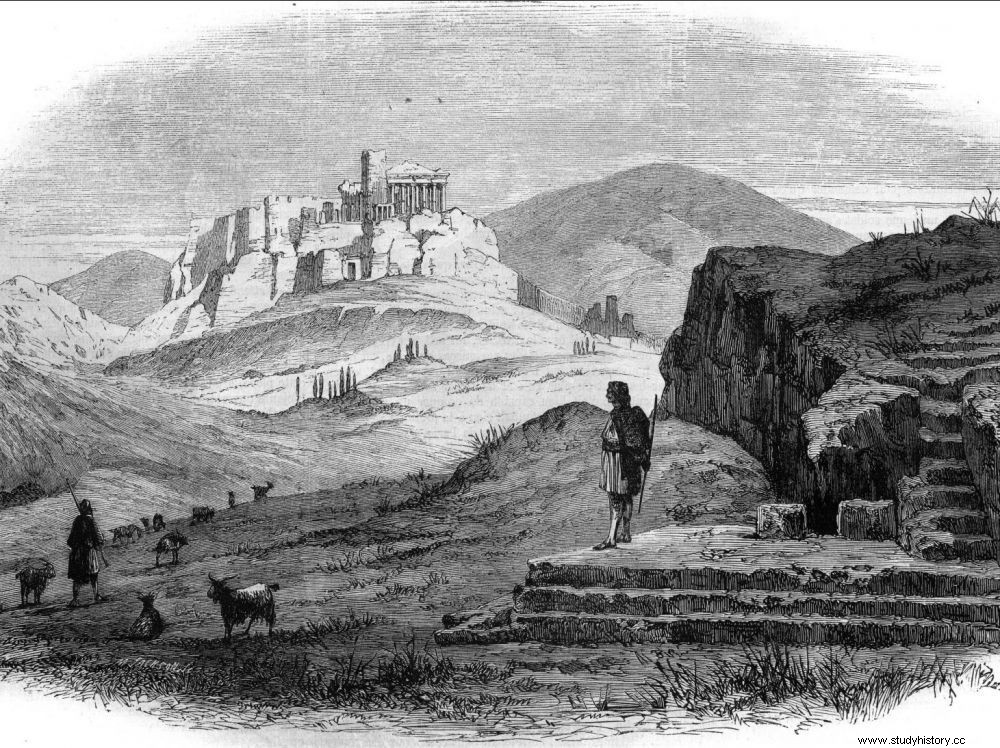In ancient times, the Pnyx hill, where Emmanuel Macron chose to speak, was used to host the Assembly of Citizens of Athens. Paulin Ismard, historian of ancient Greece, discusses the importance of this cradle of democracy.

View of the Pnyx, the hill of Athens west of the Acropolis, where the assembly of Citizens met in antiquity. Engraving after M.F. Sargeais, 1864.
On a two-day official visit to Greece, Emmanuel Macron, President of the Republic, wished to deliver a major speech on Thursday, September 7, 2017, on the Pnyx hill, in Athens. In this symbolic place near the Acropolis, sat from the VI e century before our era the assembly of the citizens of the ancient city. Why did you make such a choice? We asked Paulin Ismard, historian of Ancient Greece, lecturer at the University of Paris-1, to explain to us the importance of this emblematic site, often described as the cradle of democracy.
S and A:What in Athens is called the Hill of the Pnyx and why is this place famous?
Paulin Ismard: This hill of Athens became, from the moment when the institutions of the Athenian city were set up from the beginning of the VI e century before our era, the place where the Assembly of all the citizens of Athens met, the ekklésia , the great innovation of the political life of this city. This is an exceptional place. This is where the experience of free speech and deliberation took shape. However, in political life, the beating heart of Athenian democracy was located on the Agora, 400m below, rather than on the hill of the Pnyx.
Who had access and voice?
All the citizens of Athens, without distinction rich or poor, could sit in the Pnyx. These citizens were exclusively men, adults (aged over 18), of whom we know from the texts that they numbered a little over 40,000. Out of a total population of 200,000 to 300,000 inhabitants, they therefore only a small fraction of the whole population. [Women, slaves and non-Greeks were excluded. Editor’s note ]. What must be understood is that compared to all the other Greek cities, as well as the Athenian political formations which were contemporary to it, the very great novelty of the Assembly of the Pnyx was for the citizens of 'Athens, to be politically equal and have the same political status, allowing them to speak out. Besides, the rite with which the Assemblies opened was magnificent! A herald stood in the center of the Gathering, asking the solemn and ritual question:"Does anyone wish to speak? ". The speaker who wished to do so would then have to rise to the center of the auditorium, where a crown was placed on his head before he spoke! About 6,000 citizens could be accommodated at the same time on the Pnyx.
How long was Pnyx Hill in use?
The Athenian democratic regime disappeared in 87 BCE with the Roman conquest of Sulla. But the Assembly continued to meet on the Pnyx for at least four centuries.
It is often said that Socrates was tried and condemned to death there?
No. Socrates was not judged by the Assembly on the Pnyx. He was condemned by the Athenian Courts. A trial for impiety, which was in effect a political trial. Socrates paid for having been too favorable to the oligarchs, and therefore for having been an opponent of democracy. He was attacked on his pedagogy, and the way he taught his disciples.
